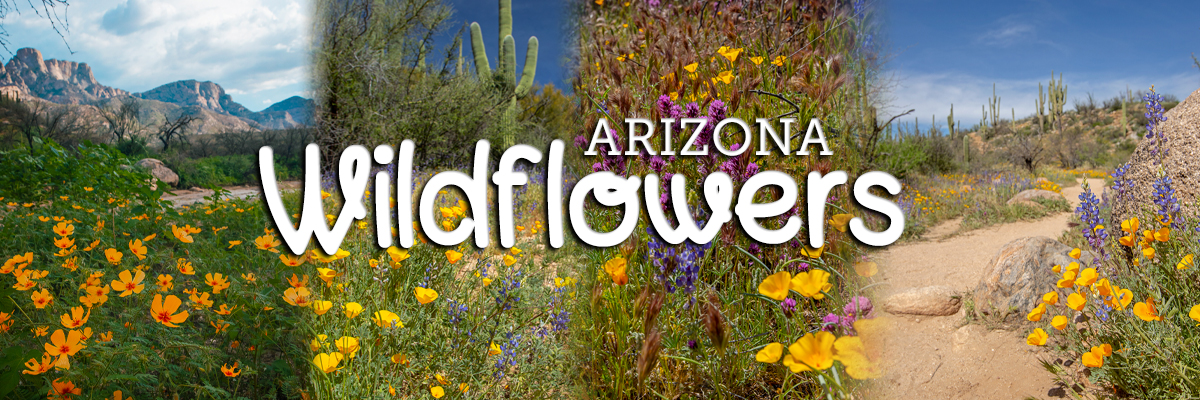
Arizona's Wildflowers
Check out our extensive Arizona wildflower list at the bottom of the page, complete with vibrant photos and bloom information! How many will you see in 2025?
Winter showers make springtime wildflowers in the desert parks and create yet another reason to explore this beautiful state! During years of average and above-average precipitation, it seems every direction you look there are beautiful yellow, red, white, orange, blue, or purple flowers blanketing the landscape. Even in years of below-average precipitation, like this past winter, resulting in a smaller size and scale of wildflower blooms, there are still many resilient and beautiful native wildflowers to look for across the state!
For more information about what flowers you can hope to see, check out our wildflower brochure.
At lower elevations of the state, like Catalina State Park, the fragile flowers of early spring's bloom, like California poppies usually make their appearance in March and April, with the Sutherland Trail being an easily accessible and greater concentration area for blooms. Picacho Peak State Park, a popular destination for petal peepers in past years of superbloom, typically sees wildflowers begin to bloom in early March with patches of golden California poppies and purple lupines. Resilient wildflowers like yellow brittlebush and peach globemallow delight even in drier years. In May in the Sonoran desert, saguaro blooms and other cactus flowers steal the show!
Parks at higher elevations see flowers later in the spring, around May, and the blooms last well into the summer. There's typically more rainfall up north, creating optimal conditions for beautiful northern Arizona wildflowers to grow. Red Rock State Park in Sedona will experience blooms like penstemon, spiderwort, bluedick, Blackfoot daisies, and milkvetch. Many flower species are small and grow low to the ground, so keep your eyes open and don't miss these commonly-overlooked tiny blooms. In the northeast region of the state, along the Little Colorado River, blossoms near Homolovi State Park show off their beauty in the late spring. Species found there include Navajo Yucca Yucca baileyi, Spreading Fleabane Erigeron divergens, Red-Dome Blanket-Flower Gaillardia pinnatifida, Mormon-Tea Ephedra viridis, Adonis Blazingstar Mentzelia multiflora, Globemallow spp. Sphaeralcea, Fragrant White Sand-Verbena Abronia elliptica, pale evening primrose Oenothera pallida subsp. runcinata, Flaxflowered Impompsis Impompsis longiflora, Prickly Pear Opuntia Polycantha, Desert Princesplume Stanleya pinnata, rose heath Chaetopappa ericoides, Rusty Lupine Lupinus pusillus, Touristplant Dithyrea wislizeni, Rat-Tail Cholla Cylindropuntia whipplei, Yellow-Saucers Malacothrix sonchoides, and Prairie Zinnia Zinnia grandiflora.
The contrast of vibrant flowers against the backdrop of green vegetation and rocky landscapes is a unique kind of beauty. So get your camera, comfortable outdoor shoes, and plenty of water and enjoy the rich colors across the state. Watch the video below as Carlos with Arizona State Parks and artist Annemarie Comes share quick tips on enjoying the desert's colorful display.
Native Arizona Wildflowers
Arizona’s flowering plants bloom at various times of year, although the spring wildflower season is generally the best time to view unforgettably vibrant fields of color. Provided there has been ample late winter/early spring rains, Arizona’s deserts absolutely come alive from late February through April and draw in visitors from around the world to admire the splendor. Many of these flowering desert plants attract hummingbirds as well to truly accentuate a colorful springtime park experience! Check out the following list of wildflowers you can find in Arizona's State Parks.
Arizona Rosemallow Hibiscus biseptus
This perennial hibiscus blooms April through October and can grow up to three feet plus in height. Yellow-cream flowers are the most common throughout Southern Arizona, although localized blooms of white or red might also be encountered in the mountain foothills and rocky canyon slopes preferred by Arizona Rosemallow.
Bluedicks Dichelostemma capitatum

This member of the lily family has a large range that encompasses the lowest deserts up to seven-thousand feet! Bluedicks may not actually be blue, depending where you are...White, purple, and pink flowers may be experienced throughout their range.
Brittlebush Encelia farinosa

Many of Arizona's rocky desert slopes and hillsides are alive with the yellow flowers of brittlebush in the spring. This is a very common, yet extremely gorgeous wildflower species.
California poppy Eschscholzia californica

The California poppy is found throughout the Sonoran Desert and in great abundance during years of above-average precipitation.
Chuparosa Beloperone californica

The semi-succulent tubular flowers of the chuparosa are typically red, although orange and yellow variants can be found throughout the sonoran desert range. Chuparosa flowers are a favorite of hummingbirds wintering in the desert.
Coulter's Lupine Lupinus sparsiflorus

Typically found below 4,500 feet in central and southern Arizona, the (usually) bluish-purple flowers of this pretty annual can vary to varying degrees of pink and even white. Flowering season is March to May.
Desert Chia Salvia columbariae

Of the 16 species of Salvia found in Arizona, the Desert variety is by far the most widespread. The blue (or purple) flowers typically bloom from March to May at desert elevations below 3500 feet.
Desert Chicory Rafinesquia neomexicana

This small member of the sunflower family sports white flowers, is usually less than two-feet tall, and occurs in gravel or sandy areas of both the Mojave and Sonoran Deserts between 200 and 3,000 feet in elevation.
Desert Gobemallow Sphaeralcea ambigua
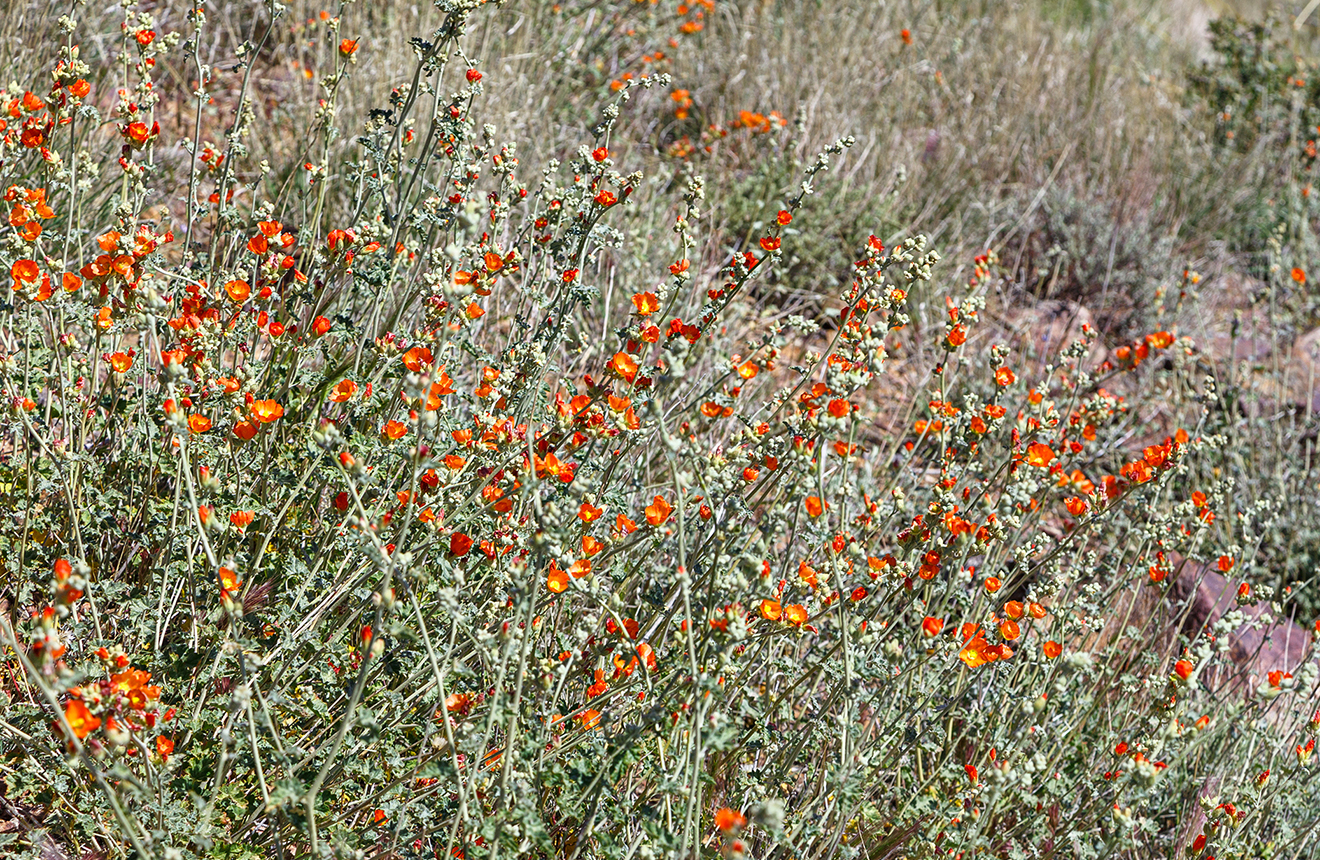
The Desert Globemallow could reach a height of 3-feet and prefers rocky, alkaline soil within creosote and desert chaparral communities below 3,500 feet in elevation. Orange blooms are most common, although pink or purple might be encountered in localized areas. Blooms year-round, peaks in spring with enough moisture.
Desert marigold Baileya multiradiata

A conspicuous desert perennial with a short life span that flowers in March and intermittently through November. Found on rocky slopes and sandy areas of the desert floor from 100 to 6000 feet in elevation.
Desert Paintbrush Castilleja integra
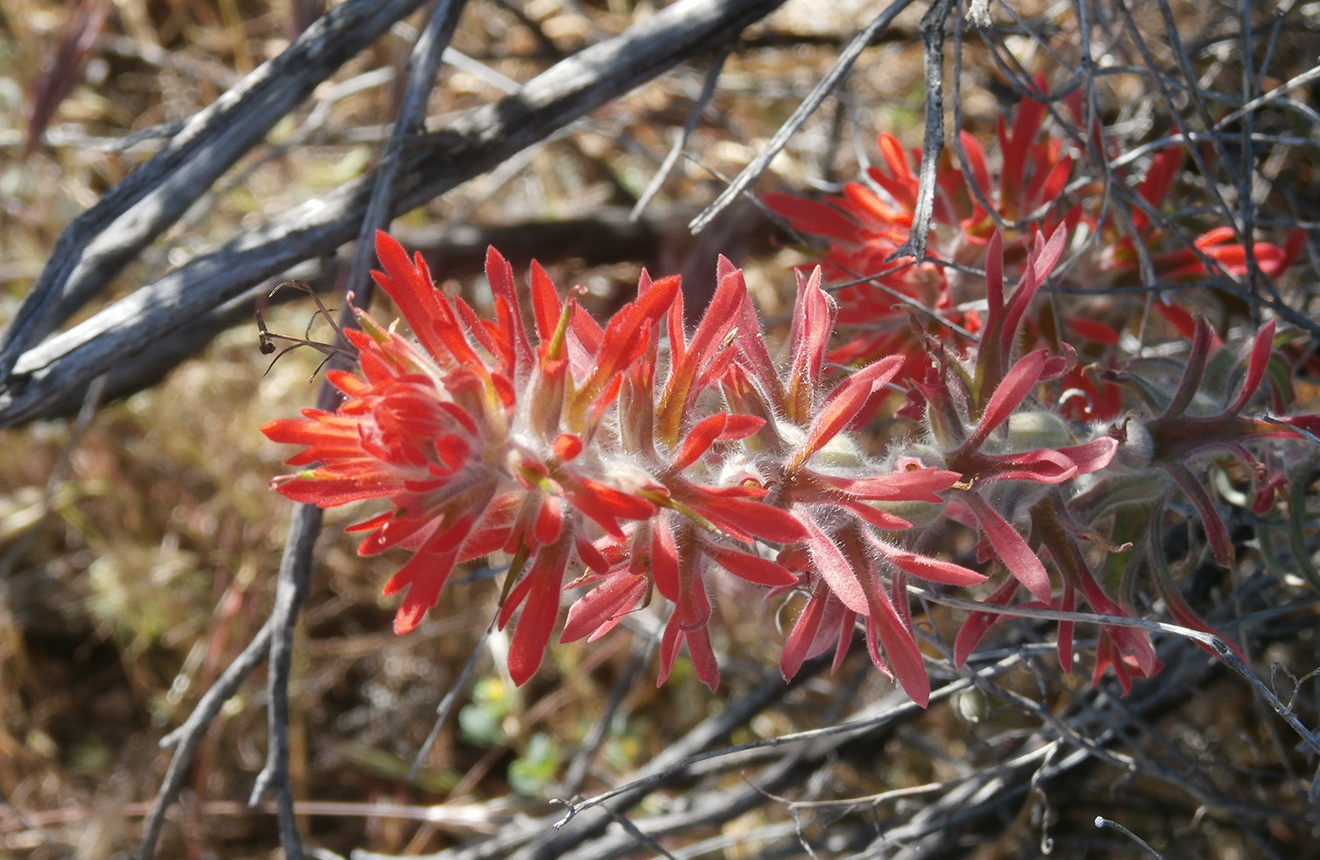
The Desert Paintbrush is a short perennial herb that occurs in dry sagebrush scrub and pinyon/juniper woodland habitats where it is partially parasitic on the roots of other plants. Bright red bracts attract the attention of butterflies, hummingbirds, and other pollinators since their flowers are small and inconspicuous.
Desert Primrose Oenothera primiveris

Found from the desert floor up to 4500 feet in elevation, these annual herbs commonly bloom on the sandy desert floor and associated topography like hills and washes.
Desert Tobacco Nicotiana obtusifolia
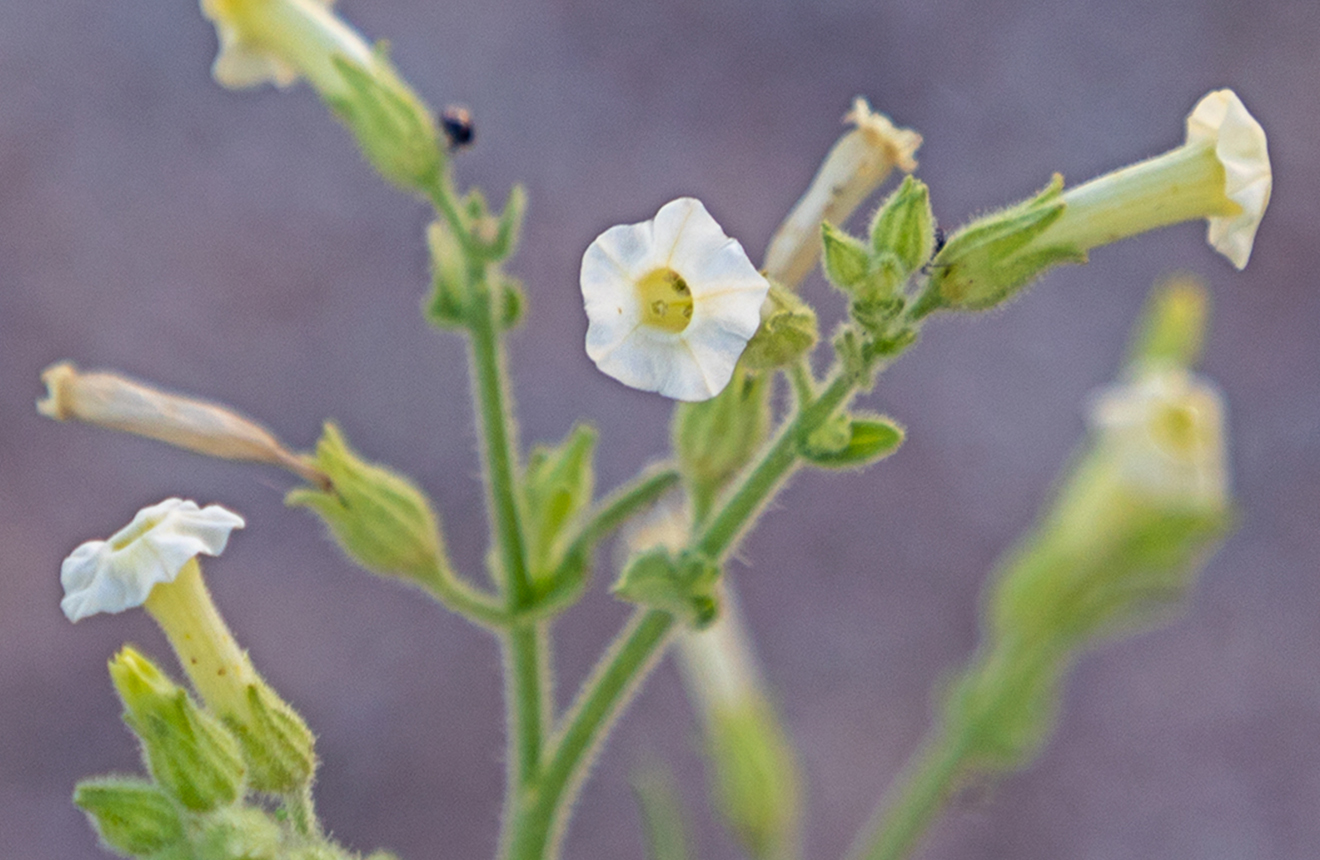
Desert Tobacco is part of the Nightshade and Potato family and grows less than 2.5-feet in height. The small, white, tubular flowers may bloom from March through June, but could bloom throughout the year with enough moisture. Desert tobacco can be found along sandy washes, and amid rocky slopes up to 6,000 feet in elevation.
Desertstar Daisy Monoptilon bellidiforme

This annual herb is usually found in desert washes and other sandy locations below 3000 feet in elevation. This ground level desert plant grows in clusters adorned with small white flowers.
Gravel Ghost Atrichoseris platyphylla

Typically found in desert washes and valleys below 4500 feet, these white flowers seem to be "ghostly" floating on their tall (up to 2.5 ft.) thin stalks.
Fairy duster Calliandra californica

The thin, wispy flowers range from light pink to orange throughout the desert region. The Fairy Duster, an important food item for a variety of desert dwelling birds and animals, is found below 5,000 feet on open hillsides and sandy washes.
Fiddleneck Amsinckia intermedia

During years of above-average rainfall, the yellow-orange flowered fiddlenecks will be particularly abundant and found in dense patches in the upland desert. This plant irritates human skin upon contact.
Jojoba Simmondsia chinensis
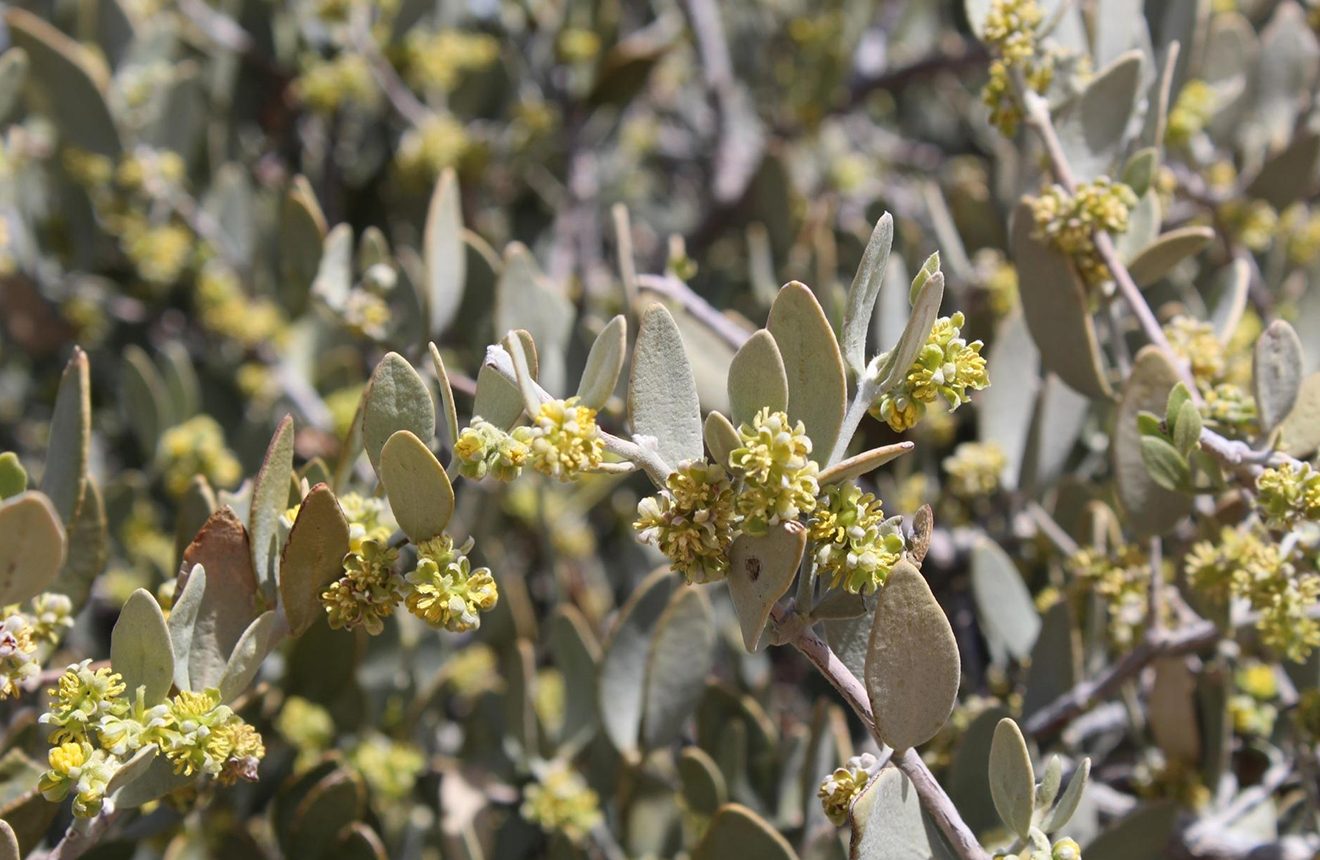
Jojoba is an economically valuable plant. The wax extracted from jojoba nuts is a very high-quality lubricant found in many cosmetics and beauty products. Jojoba plants bloom during the winter months and the nuts ripen over the summer. Jojoba is found throughout the Sonoran desert in areas that get enough moisture to support them.
Lyreleaf Jewelflower Streptanthus arixonicus

This small biennial to annual flowering herb is actually a member of the mustard family. Interestingly, the white flowers turn to yellow the further east in range occurrence. In Arizona most jewelflowers are white.
Marsh Aster Aster pauciflorus

Marsh Aster is found in riparian and drainage zones throughout Arizona. As the name implies, this forb is found within close proximity to a regular water source.
New Mexico Thistle Cirsium neomexicanum
This forb can reach a height of over six feet tall throughout its range. The thistle blooms from March through September after above-average rainfall.
Purple Mat Nama demissum

A small spring annual that grows in large "mats" sporting numerous purple flowers. Present only after above-average winter precipitation in desert flats, and somewhat rocky areas near washes.
Purple Owl's Clover Castilleja exserta

After periods of above-average rainfall, these beautiful annual forbs can produce huge swaths of color in generally open desert areas from March through May.
Rock Daisy Perityle emoryi

A small, delicate, annually recurring herb, the Rock Daisy is usually found in relatively open rocky or sandy desert areas.
Sacred datura Datura wrightii
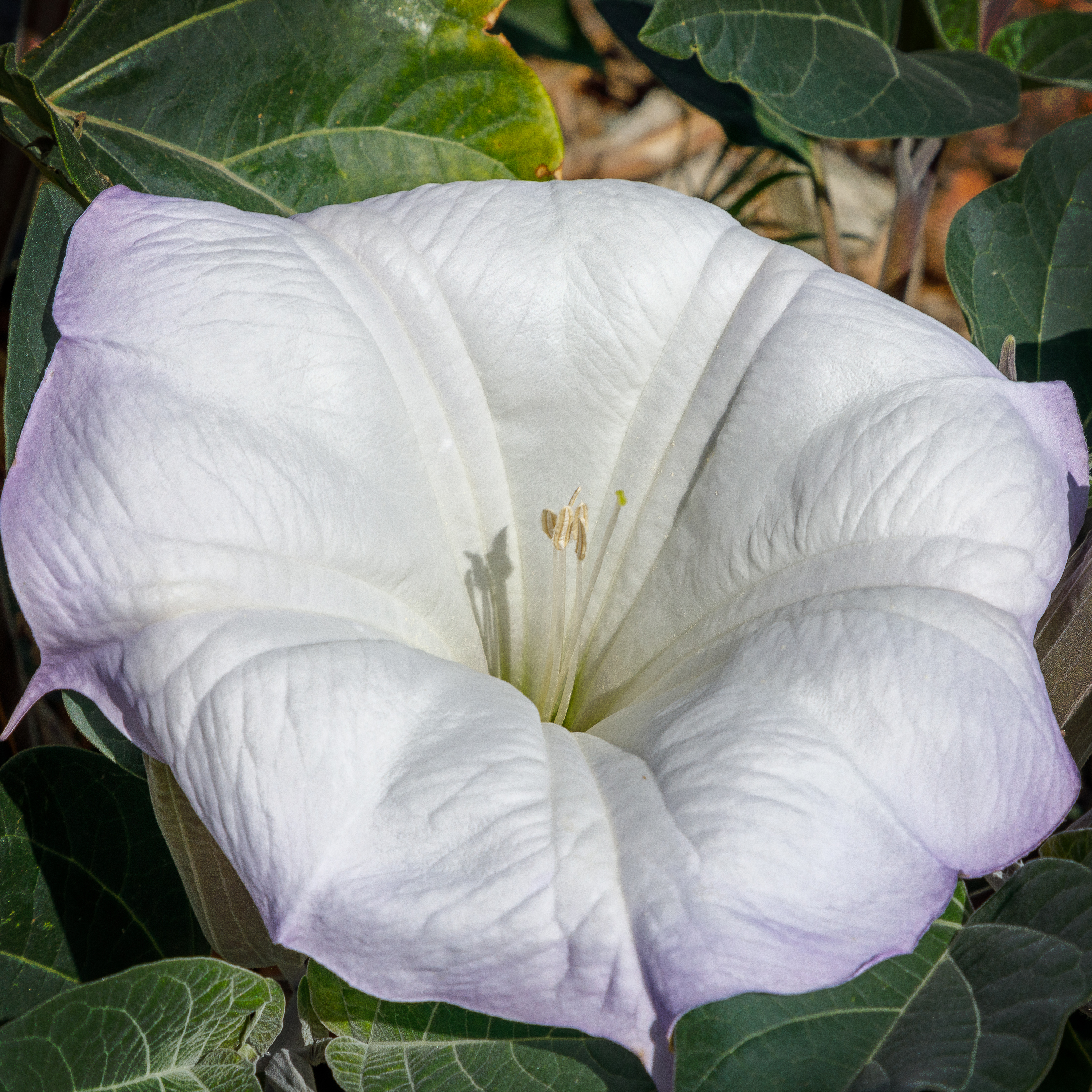
A weedy species with showy white flowers found growing in disturbed areas. All parts of the plant are poisonous.
Scorpion weed Phacelia distans

Scorpion weed usually blooms from February through June and is found typically along desert washes and hillsides between 1,000 feet and 4,000 feet.
Yellow Cups Camissonia brevipes

Flowering best during years of above-average desert rainfall, these small yellow flowers typically occur in western Arizona between 300 ft and 6000 ft elevation.
You can always contact the parks by phone to see what blooms have made their appearance! February is the earliest wildflowers will start to bloom, and often they wait until March. The season depends on precipitation and temperature, so you never know what you'll see!
Always remember to treat the landscape and blooms with respect, and be careful not to pick or trample the flowers! Help us keep the parks beautiful for all visitors to Arizona State Parks!


